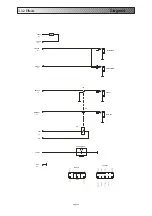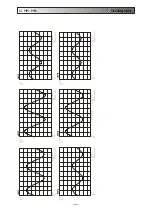
2.3
Short-circuit protection
Power amp / Protections
Testing/Regulating
When the device is switched on, there should be a noticeable delay before it powers up.
You should be able to hear the relay operating. The length of the delay should be about
two seconds.
The following procedure is used to test the circuit that protects against DC voltage at the
output:
Switch off the device
Removed fuses
to
(
)
Connect a multimeter to the emitter of transistor T17 (
)
Connect a stabilised DC source (
) to the output
Switch on the
Now slowly raise the DC voltage at the
's output (positive and negative tests) until
the device is seen to switch off (the Mute LED will illuminate and the relay will switch off).
When the switch-off occurs, the voltage at T17 should be c. 0.6V.
If the
has not switched off by the time the DC source voltage reaches 3V, there is a
fault.
Note that there is an electrolytic capacitor in the protective circuit to ensure a sluggish
response. That is why it is essential to increase the voltage slowly. The external DC voltage is
interrupted when the relay switches off and after a short interval, during which the power
amplifier will be in Standbymode,itwillreturntoOperatingmode
Before performing this test, the stabilised DC voltage power supply should be set to +8V.
The simplest way of connecting the Earth is to connect it
to the
(Minus). The other output of the
voltage source is connected to NTC2. (
)
When testing the short-circuit protection, a 4ohm (250W) load
resistance is attached to the
of the amplifier and an
additional 1 (250 W) ohm load resistance to the earth of the
output (see Fig. 4) A sine wave signal of c. 1kHz should be
applied to the
and increased until the
oscilloscope at the output shows
DC Voltage Protection
Temperature control
⋅
⋅
⋅
⋅
⋅
Si1
Si2
ProFetII
Pro Fet IV
Pro Fet II
Speaker Out
Speaker Out
Effects Return
take care to discharge the input capacitors
1V range
set to 0V
Attention: one
pin of NTC 2 is connected to Earth
.
The following table shows how the protective circuit
reacts at various operating points.
Here too it should be borne in mind that the stated
voltage values are approximations and a variation of +
or - 10% is permissible.
Page 6
Fan ON
Standby ON
Standby OFF
Fan OFF
6V
7,5V
3,5V
4,5V
Fig. 4.: Short-circuit test
(SPEAKER OUT)
TTENTION:
If it becomes neccesary to replace a broken power amp transistor, it´s strongly
recommendet to use original spare parts supplied by the maufacturer only. Also,
even in case of ONE broken power amp transistor, you should replace the whole
set, which means 2x
or 2x
IRFP9240
IRFP240.




































